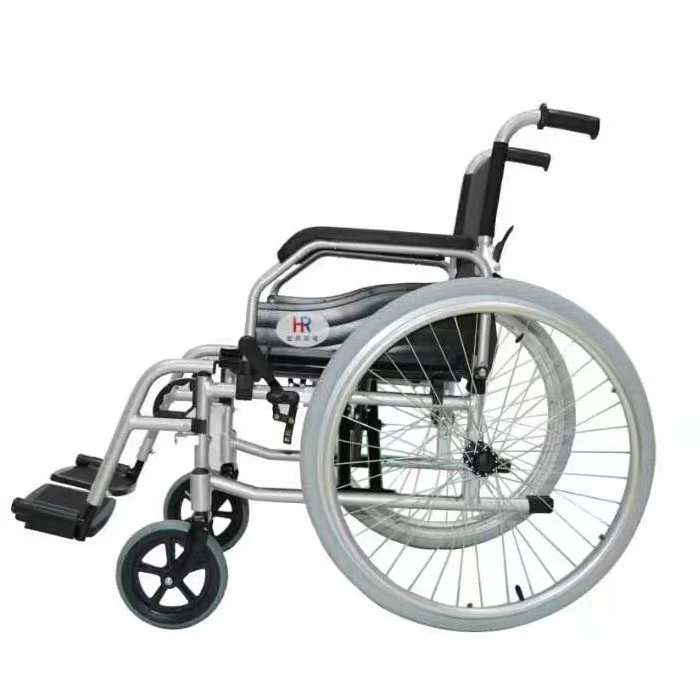Mobility aids, such as wheelchairs and transport wheelchairs, play an essential role in the lives of individuals who require assistance with movement. Both devices offer critical support, yet they serve distinct purposes and are optimized for different user needs. Understanding their differences can significantly impact your choice when considering these invaluable tools.
Design and Construction Differences
● Frame and Material Variations
One of the primary distinctions between a standard wheelchair and a transport wheelchair lies in their design and construction. Standard wheelchairs are typically built with robust frames designed to support independent movement, often featuring larger rear wheels that users can propel themselves. These frames tend to be heavier and more durable to ensure stability and long-term use.
In contrast, transport wheelchairs are constructed with lightweight materials to enhance portability and ease of use in assisted scenarios. The frames are usually compact, making them more manageable for caregivers who need to lift and transport the chair. Materials like aluminum or composites are common, contributing to a lighter overall weight. This design focus makes transport wheelchairs ideal for short-term use and convenience in travel settings.
● Weight and Portability Distinctions
Portability is a key selling point for transport wheelchairs, as they are specifically engineered to be easily folded and stored. Many transport wheelchair manufacturers emphasize compact designs that can be quickly disassembled or collapsed, making them easier to fit into car trunks or storage spaces. This makes them particularly useful for individuals who travel frequently or have limited storage capacity.
While some wheelchairs also offer folding capabilities for storage, they generally require more effort to disassemble and transport due to their larger size and weight. However, advances in wheelchair technology have led to the development of lightweight wheelchairs that aim to bridge the gap between the two types, offering higher portability while maintaining some degree of independent use.
Functionality: Self-Propelled vs. Assisted Mobility
● Independent Mobility in Standard Wheelchairs
A standard wheelchair is designed to provide users with a significant degree of autonomy. The larger rear wheels are fitted with hand rims, allowing users to propel themselves independently. This feature makes standard wheelchairs ideal for individuals who have the upper body strength and dexterity to maneuver the chair without assistance.
● Need for Assistance with Transport Wheelchairs
Transport wheelchairs, on the other hand, are built with smaller wheels and require a caregiver or attendant to push the user. This makes them less suited for individuals seeking independence, but ideal for those who need assistance, such as elderly patients or individuals recovering from surgery. In situations where long-distance travel within a healthcare facility or during outings is required, transport wheelchairs offer a practical solution by allowing caregivers to maneuver with ease.
Who Should Use Each Type?
● Ideal Users for Standard Wheelchairs
Standard wheelchairs are perfect for individuals who require daily mobility assistance but possess enough strength or capability to navigate independently. These are often seen in homes, workplaces, or communities where users spend significant time moving around without reliance on others.
● Best Candidates for Transport Wheelchairs
Transport wheelchairs, purchased from reputable transport wheelchair suppliers, are best suited for individuals needing occasional mobility aid or those who are always accompanied by a caregiver. They are a common sight in hospitals, airports, and other public spaces where short-term mobility solutions are necessary. For these users, the ability to easily transport and store the chair is often more valuable than full independence.
Maneuverability and Terrain Suitability
● How Each Type Handles Different Surfaces
Standard wheelchairs typically come equipped with larger rear wheels, providing better grip and stability across a variety of surfaces. This feature enhances maneuverability over uneven or outdoor terrain, making them a suitable option for users who frequently travel outdoors.
Transport wheelchairs, while easy to navigate on smooth, indoor surfaces, may struggle on rough or uneven terrain due to their smaller wheels. They are less adept at handling obstacles like curbs and gravel paths, which can limit their usability outdoors.
● Outdoor vs. Indoor Use Considerations
When choosing between a wheelchair and a transport wheelchair, consider where the majority of usage will occur. For users who plan to spend a lot of time outdoors, investing in a standard wheelchair with larger wheels and enhanced maneuverability is advisable. Conversely, for primarily indoor or short-distance use, a transport wheelchair offers convenience and ease of use.
Comfort and Seating Options
● Cushioning and Seat Construction
Comfort is a critical factor to consider when selecting a mobility aid. Standard wheelchairs often feature customizable seating options, allowing users to adjust the chair for optimal support and comfort. Padded cushions and ergonomic designs are standard, providing relief during extended periods of sitting.
Transport wheelchairs, while comfortable for short durations, generally offer fewer customization options. They are designed for temporary use and may not provide the same level of seating support as standard wheelchairs. However, many transport wheelchair manufacturers are now focusing on enhancing comfort to meet diverse user needs.
● Customization Levels Available
Standard wheelchairs frequently offer extensive customization options, allowing users to modify components like armrests, footrests, and back supports. This adaptability is beneficial for long-term users who may have specific requirements or medical conditions that necessitate tailored solutions.
Transport wheelchairs, being more straightforward in design, offer fewer customization possibilities. They are often considered a "one-size-fits-all" solution, prioritizing ease of use over individual personalization.
Safety Features and Considerations
● Brakes and Stability Mechanisms
Safety is paramount when considering a mobility aid. Standard wheelchairs come equipped with manual brakes that users can operate independently, providing control over speed and movement. These chairs are designed with stability in mind, offering features like anti-tip bars to prevent falls.
Transport wheelchairs also include safety features such as attendant-operated brakes and seat belts. These features are crucial for ensuring the user’s safety, particularly when navigating slopes or inclines. Given that transport wheelchairs are reliant on a caregiver, the braking systems are often situated at the handles for quick access.
● Restraints and Safety Belts
Both types of wheelchairs can be equipped with additional safety features like harnesses and seat belts to secure the user in place. These restraints are especially important for users who may have difficulty maintaining an upright position or are at risk of slipping from the chair.
Storage and Portability
● Folding and Storage Capabilities
Storage solutions are a significant consideration when choosing between a standard and transport wheelchair. Transport wheelchairs are designed to be extremely portable, with folding mechanisms that allow the chair to collapse into a compact form. This design feature is particularly convenient for travel, as the chair can easily fit into the trunk of a vehicle or be stored in a closet.
While some standard wheelchairs offer folding capabilities, they are generally bulkier and require more space. Advances in design have led to hybrid models that offer lightweight frames and foldable features similar to transport wheelchairs, providing a middle-ground for users seeking portability without sacrificing independence.
● Ease of Transport in Vehicles
Transport wheelchairs’ lightweight design makes them particularly easy to lift and place into vehicles, even for individuals with limited strength. This ease of transport is a significant advantage for caregivers who need to frequently move the chair from place to place.
In contrast, standard wheelchairs may require more effort to transport due to their heavier frames. However, they can often be disassembled into smaller components, making them more manageable when travel is necessary.
Cost and Insurance Implications
● Price Differences and Affordability
The cost of a wheelchair or transport wheelchair, available from wholesale transport wheelchair suppliers, can vary significantly depending on materials, design, and additional features. Standard wheelchairs, being more complex and supportive of independent use, tend to be more expensive than transport wheelchairs.
Transport wheelchairs are often more affordable due to their simpler design and intended use. They are a cost-effective solution for those needing temporary mobility assistance or for use in specific situations like travel or hospital visits.
● Coverage Options by Insurance Providers
When selecting a mobility aid, it is essential to consider available health insurance coverage. Standard wheelchairs, often considered medically necessary equipment for individuals with long-term mobility issues, are more likely to be covered by insurance providers.
Transport wheelchairs, due to their temporary usage nature, may not always receive the same level of coverage. However, many plans do offer partial coverage or rental options, making it important to consult with your insurance provider for details.
Conclusion: Choosing the Right Mobility Aid
● Summary of Key Differences
In summary, the decision between a standard wheelchair and a transport wheelchair should be guided by the user's needs, lifestyle, and level of independence required. Standard wheelchairs offer independence, extensive customization, and are better suited for long-term use and diverse terrains. Transport wheelchairs, sourced from reliable transport wheelchair factories, offer convenience, portability, and ease of use for short-term situations and travel.
● Factors to Consider When Making a Decision
When deciding between these two types of wheelchairs, consider factors such as the intended use, the need for independence versus assistance, storage and transport requirements, comfort preferences, and financial implications. Understanding these key differences can help ensure you select the most suitable mobility aid for your needs.
About Excellent: A Leader in Mobility Solutions
Suqian Excellent Science And Technology Co., Ltd is a premier manufacturer of rehabilitation therapy supplies based in Suqian City, Jiangsu Province. Under the brand name EXCELLENT, we offer an array of products including wheelchairs, mobility scooters, and patient lifts, designed with the highest quality standards. Our commitment is to enhance mobility and improve the quality of life for users around the globe, backed by certifications from CE, FDA, SGS, ISO9001, and more. With a focus on innovation and customer satisfaction, EXCELLENT products are trusted worldwide for their exceptional performance and reliability.

Post time: 2024-12-29 10:30:05

.png)





































